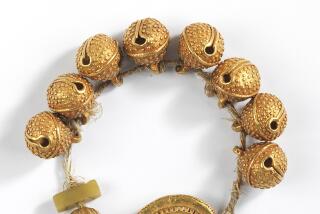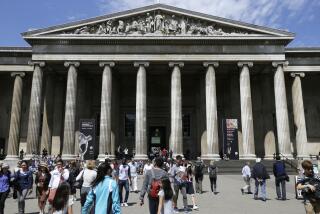Getty curator at the center of past looting scandals has been writing a memoir

Former J. Paul Getty Museum curator Marion True leaves the courthouse in Rome where she was being tried on charges of being part of a stolen-art ring in 2005. The charges were later dismissed.
- Share via
In the decade-old saga of looted antiquities at the J. Paul Getty Museum, a firestorm that led to a transformation in professional standards for museums that actively collect ancient art, one prominent voice has remained relatively quiet. Now, there seems to be at least a possibility that might change.
The Washington Post reported Thursday that Marion True, the distinguished Getty curator who took the fall for an entire profession then riddled with lapses — ethical and otherwise — in buying stolen art for their museums, has roughed out the draft of a memoir. But she’s not sure she should finish it.
“I felt I really had to put it down, from my perspective, as a kind of catharsis,” True told the newspaper about her rough draft of a very rough period in her professional past. “But I’ve been wavering. Do I really want to publish a book and turn my life upside down?”
SIGN UP for the free Essential Arts & Culture newsletter >>
Her hesitation is understandable, given the relentless, often inflammatory media glare that accompanied her unprecedented 2005 indictment by an Italian court on charges of being part of a stolen-art ring. (The charges were later dismissed, but her career was over.)
She couldn’t speak publicly then, for obvious legal reasons. Yet I hope she changes her mind now. It could be an important book.
Although an urge to call out colleagues and others would no doubt be strong, forget a score-settling tell-all. Settling history is more important. A central irony in the case remains unresolved.
Before the looting story blew up, True was in the forefront of initiating necessary changes in the museum profession dealing with the extremely thorny subject of looted antiquities. That important (if unglamorous) fact was largely lost in the blaze of the paparazzi’s flashbulbs.
True certainly didn’t have all the answers. And she made her own serious missteps along the way — including taking two $400,000 personal loans, one arranged through a London antiquities dealer and the other (to pay back the first) from New York art collectors whose antiquities the Getty acquired. The shocking revelation rightly prompted her resignation.
But museums are sluggish institutions, and procedural change comes slowly. In the complex matter of looted antiquities, True was feeling her way through the underbrush. While others in the profession knew of the problems but either resisted change or merely looked away, she was heading in the right direction.
The complex story of the indictment and court proceeding is laid out in “Chasing Aphrodite: The Hunt for Looted Antiquities at the World’s Richest Museum,” the 2011 book by former Times reporters Jason Felch and Ralph Frammolino. One of its flaws, however, is a failure to adequately represent True’s trail-blazing reform efforts within the larger context of a stolid museum profession. The lapse skews the story.
A straightforward recitation from the once-embattled curator could go a long way toward rectifying that. Not only would it provide necessary balance in understanding True’s participation in tumultuous events that have changed the way art museums now operate, it would also help us understand why those changes needed to be made — and what changes still need to come.
Twitter: @KnightLAT
MORE:
Bronze sculptures in ‘Power and Pathos’ at the Getty capture pivotal era
Getty to show exact replicas of art-filled Buddhist caves in China
Why you need to see the Getty’s collection of video art from Latin America
More to Read
The biggest entertainment stories
Get our big stories about Hollywood, film, television, music, arts, culture and more right in your inbox as soon as they publish.
You may occasionally receive promotional content from the Los Angeles Times.











